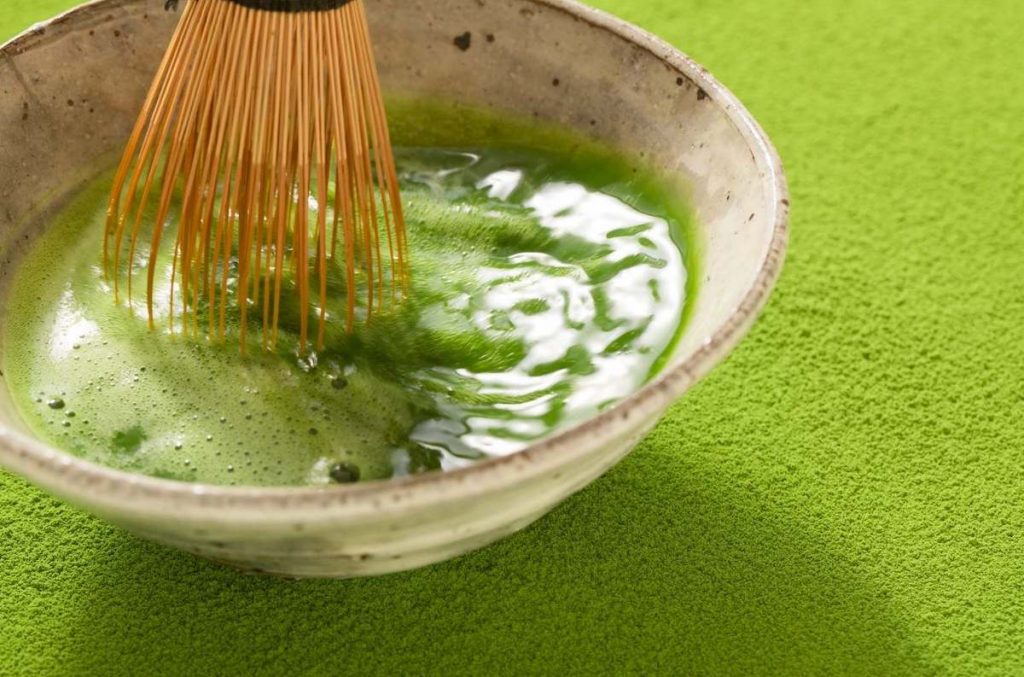Matcha is a food with a lot of health benefits. Matcha is packed with valuable nutrients like vitamins, antioxidants, and polyphenols. Since it’s a fine powder, you can enjoy it in a variety of drinks and foods. It’s also good for your gastrointestinal system (your gut health). It’s good for your teeth and gums. It even might aid hair growth.
But as “super” as matcha is, it’s not a superfood.
The truth is, there are no “superfoods,” only super foods.
Superfoods are more of a social construct than a scientific definition. By deconstructing the superfood concept, you can learn what foods are super for their health benefits and not just for being the latest social trend.
What does “superfood mean”?
Superfood doesn’t have a standard definition. It’s a trendy idea or marketing BS just like you see on ab-toning devices, motivational speakers’ pitches, and whatever woo-woo stuff a certain actress is trying to pass off as magical and curative.
Broadly, foods rich in special nutrients like antioxidants or fiber, and with some health benefits, whether proven or speculated, are called superfoods.
Many foods have all these features, but just a few have been called superfood. The beauty of the term is that it can be slapped on anything since it’s not claiming health benefits. Though even that is changing.
Originally, mostly foods that were almost unknown in Western countries reached the superfood status. It’s easy to romance things that are old and unknown to us.
Those foods already were common in Eastern countries before gaining popularity in the West. These superfoods include:
- Turmeric
- Ginger
- Seaweed
- Yogurt
- Moringa
- Seafood
- Nuts
- ..Water!
And our dear friends, green tea and matcha, have been labeled as superfoods.
What do these have in common? They’re all, likely, healthy, in moderation but perhaps in larger doses. The science, in most cases, just isn’t there. And if the science isn’t there, you have no basis for proof as we know it.
Now even common foods like fruits and veggies are getting the superfood status. These foods have vitamins and other nutrients. But there isn’t any objective reason to tag them as “superfoods.”
Literally any food can be called a superfood. That means there aren’t superfoods at all.
There are, however, foods that are better for you than others. French fries are not a superfood unless you want to make the case they make you super happy. For me, it’s peanut butter. I can eat it with a spoon straight from the jar.
It is SUPER satisfying. And actually, it’s got some health benefits. Here comes’s ADAM’S SUPERFOOD PEANUT BUTTER! (with 20 g of protein per serving, of course)
The food industry has been a strong promoter of this concept. Labeling a food as a superfood allows them to jack up the price. Just like organics. The superfood claim also boosts sales even for foods already known as healthy. The industry-run marketing campaigns to guarantee the food they’re selling becomes a trend as a new superfood.
But people are very interested in the concept of superfoods, too. People have become more aware of the quality of their diets. Many want to get health benefits from foods to stay healthy or fight disease. So, they fall for this superfood concept.
Hey, I have an MBA in Marketing in addition to an MS in Health Sciences. I get it. Marketing is the “art” of leading the customer to your product or service. But good marketing is the art of being virtuous and helping people. That’s why I follow the science.
Getting back to my dear matcha.
Matcha confers super benefits. And you can benefit from them. I have the science to back this. It won’t cure cancer, heal holes in your intestines, or cure your depression. But it tastes wonderful and it will offer benefits.
What are matcha’s “super” health benefits?
Besides its nutritional contribution, matcha provides a wide range of health benefits, including:
- Anti-inflammatory
- Cardioprotective
- Antimicrobial
- Antitumor effects
- Mood improvement
Matcha contains a big serving of vitamins and polyphenols, like flavonoids, tannins, and catechins. These are antioxidants that protect our cells against harm from age or chemicals. They help us to reduce our risk of developing chronic diseases. Matcha even has a higher amount of the well-known catechins EGCG and ECG than green tea.
Matcha is a good source of an amino acid called L-theanine. This amino acid isn’t naturally present in most foods; green tea and its offshoot, matcha, are strong sources. L-theanine can reduce anxiety and physical or mental stress.
Overall, matcha consumption provides super health benefits, but it’s not a superfood. It’s a super food.
Why matcha is a super food but not a superfood
Science has proved matcha has a lot of health benefits. Those facts will remain true no matter how popular matcha is. As a nutrition trend, matcha can be substituted at any time for a new superfood. Superfood used to be a short-lived label, but in modern times many things help it to survive.
The term superfood has been around for a while. Since the early part of the 20th century, the word was used for marketing reasons. But thanks to the internet, social media, and influencers, now the term is everywhere. And people keen on new foods and health trends embraced the term and helped to spread it.
Years ago, “experts” realized the potential of matcha to become a trend in nutrition and lifestyle. That’s because it’s a novel food in the West, despite the centuries-long tradition in the East. Its health benefits only make it more popular. Matcha’s good and good for you.
Throw in some romance of Asia and Japan, and you’ve got your perfect marketing storm.
Food legislation in Europe and the U.S. has been toughening up in recent years, though.
Countries are regulating the use of misleading terms like “superfoods”. Even if the food is healthy, industry can’t use health claims when unhealthy ingredients (in excess) like salt or sugar are involved.
These laws don’t deny the benefits of foods like matcha, they just remind put a cap on misleading language.
Japan doesn’t really have “superfoods” they’re a Western thing
Many trendy foods considered healthy today have a long history in Japan. For instance, some fermented foods, like natto (fermented and stinky soybeans, which I love), currently popular in Western countries have been consumed for thousands of years in Japan.
These foods were just part of their culture, never called superfoods. Natto most likely was accidental when soybeans were left in sacks for too long. It’s rich in protein and nattokinase. So it has health benefits. No magic there.
But in the West, these foods have been treated almost like magic. Oh how we love to romance Asia.
Japan has the longest life expectancy in the world. They also enjoy a low rate of chronic diseases. It’s thought their traditional diet is what allows them to stay healthy. Their diet is different than in Western countries, with plenty of plant-based foods and fish.
They’re not perfect though. The Japanese diet is also very high in salt and sodium. Tempura’s high in calories and cholesterol. Sushi, which is formed around white rice, is full of empty carbohydrates, and surprisingly high in calories, despite the good stuff you get from the fish.
The mistake the West made was just to promote a few Japanese foods. That made people focus on single foods and forget their whole diets. Those foods alone can‘t replace a good diet. But adding those foods to a good diet provides super benefits.
And foods like matcha really can improve our lives and health. Just don’t get carried away or expect magical properties. Keep it real, yo.
How to enjoy healthily enjoy matcha in your daily life.
Matcha is a fine ground powder. So it’s quite easy to use it as an ingredient in a variety of foods. And preparing yourself those foods with healthy ingredients you’ll get all the super benefits.
The easiest way for you to consume matcha is just as a drink. Usually, that’s just mixing the powder with hot water to make matcha tea. Matcha in its traditional form is quite strong, earthy, and intense. Not everyone will take to it. I do! I love it.
You can also add ice, carbonated water (club soda), milk, dairy substitutes, or a natural sweetener like stevia to improve the flavor and presentation
And you can add matcha to your daily smoothie or protein shake. Or mix it with almost any kind of drink. Its earthiness makes it very compatible with all sorts of fruits, vegetables, and dairy products.
As an ingredient, the possibilities go on and on.
Popular foods including matcha are:
- Baked goods (cookies, brownies)
- Main or side dishes (soups, pasta)
- Desserts (cakes, ice cream)
- Other foods (matcha butter, protein bars, sweets)
Another option is just sprinkling some matcha powder over your favorite food.
You can add it at breakfast to your pancakes or cereal, to salads and sauces for your dinner, or to healthy snacks like fruit and yogurt. The inherently bitter and earthy taste goes nicely with almost any sweet taste.
In all these ways you can enjoy matcha and its health benefits. Just make sure to use high-quality ingredients to fulfill your nutritional needs as well.
So to tie this up: matcha is super. It’s a super-duper food! It’s tasty and nutrient-rich. It’s not a superfood. There are no superfoods. Sorry, my fellow marketers.

